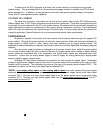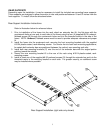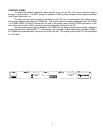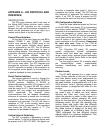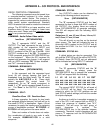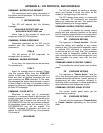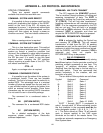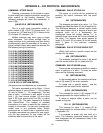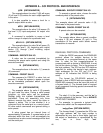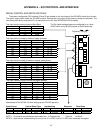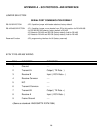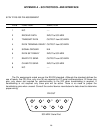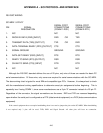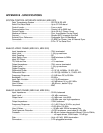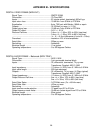APPENDIX A – SCI PROTOCOL AND INTERFACE
A5
COMMAND: STORE SALVO
Creating a transaction to be stored in a salvo
is done exactly as a regular transaction except the
salvo symbol is the leading character. The
following example will store this transaction in
salvo 2 (@):
@A10C3O19 {RETURN/ENTER}
This is a split mode transaction stored in
salvo number 2 (@ = SHIFT 2),change level 1 (A)
to source ten (10) and level 3 (C) to source three
(3) of output (O) nineteen (19).
Multiple switches may occur upon a single
salvo command. This allows multiple input to
output switches to be preloaded and then switch
simultaneously upon the execution of the salvo. A
typical multiple output salvo would be entered like
the following string of commands;
! I 01 O 01 {RETURN/ENTER}
! I 02 O 02 {RETURN/ENTER}
! I 03 O 03 {RETURN/ENTER}
! I 04 O 04 {RETURN/ENTER}
! I 05 O 05 {RETURN/ENTER}
! I 06 O 06 {RETURN/ENTER}
! I 07 O 07 {RETURN/ENTER}
! I 08 O 08 {RETURN/ENTER}
! I 09 O 09 {RETURN/ENTER}
! I 10 O 10 {RETURN/ENTER}
! I 11 O 11 {RETURN/ENTER}
! I 12 O 12 {RETURN/ENTER}
! I 13 O 13 {RETURN/ENTER}
! I 14 O 14 {RETURN/ENTER}
! I 15 O 15 {RETURN/ENTER}
! A 16 B 64 O 16 {RETURN/ENTER}
(No spaces are used between any commands.)
This salvo command is set for Salvo 1 (!) and
switches inputs (I) one to fifteen (1 - 15) to outputs
(0) one to fifteen (1 - 15) respectively. The last
step of salvo 1 performs a split switch of input
level 1 (A) from source sixteen (16) and input
level 2 (B) from source sixty-four (64) to output
(O) sixteen (16). The salvo command is finished
with Return/Enter. The number of possible
transactions in a salvo is equal to the number of
outputs in the system. You can only change each
output once in any particular salvo. Switch
commands do not need to be in numerical order.
If multiple commands are entered for one output,
only the last command for that output will be
visualized after the execution of the salvo.
COMMAND: SALVO STATUS ALL
The status of a salvo can be examined by
prefixing the status command with the salvo
symbol.
!SA {RETURN/ENTER}
The example provided is for salvo 1 (!). This
example provides the status (S) for all outputs (A).
The difference between a normal status check
and a salvo status check is anytime a level is not
assigned (such as in a breakaway), the
unassigned inputs will display dashes "---" to
indicate these input levels will not be affected by
the salvo. The dashed lines would appear at
levels 3 (C) and 4 (D) of output 16 for the sample
salvo 1 given in the previous command
paragraph.
COMMAND: SALVO STATUS SINGLE OUT
Within each salvo a specific output can be
checked for the status.
#S9 {RETURN/ENTER}
The example command for salvo 3 (#) would
yield the current status (S) for output nine (9).
COMMAND: SALVO ERASE (clear)
There are six commands available to erase a
salvo or portions of a salvo. To erase an entire
salvo use the following command.
$Z {RETURN/ENTER}
In the example above, the command will take
salvo 4 ($) erase (Z) the entire contents:
To erase only a specific output , use the
command with an output limiter attached.
@Z14 {RETURN/ENTER}
This example for salvo 2 (@) erases (Z) all
input assignments for output fourteen (14).
A range of outputs within a salvo can be
erased as a group.
!Z11-18 {RETURN/ENTER}
This example for salvo 1 (!) erases (Z) all
input assignments for outputs eleven (11) through
(-) eighteen (18).
It is possible to erase only one level of a
salvo. The following command erases only the
level designated for all transactions listed in the
command string.



